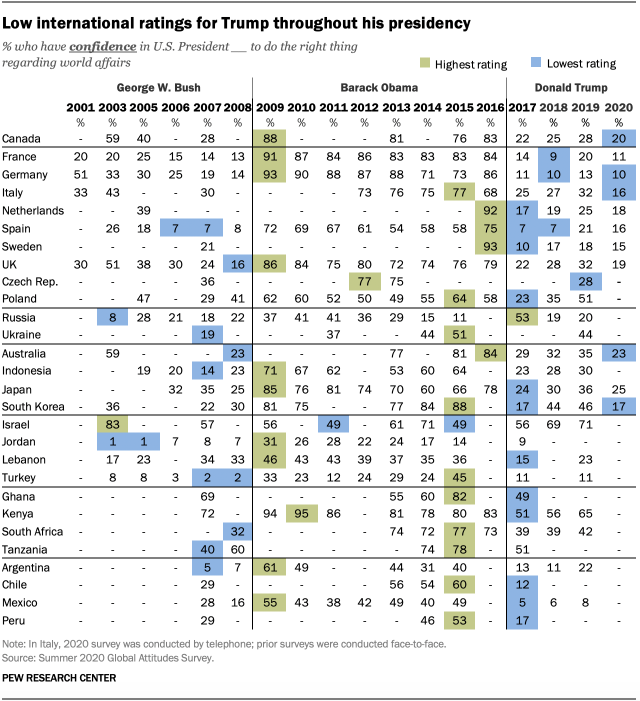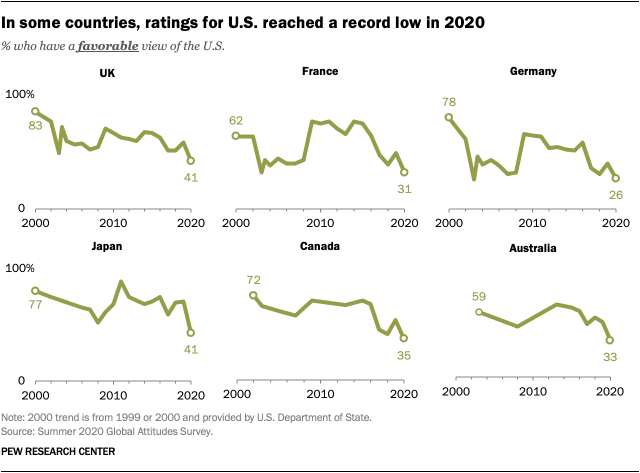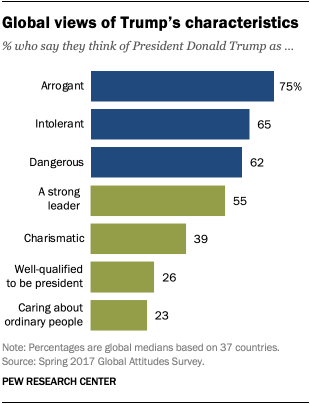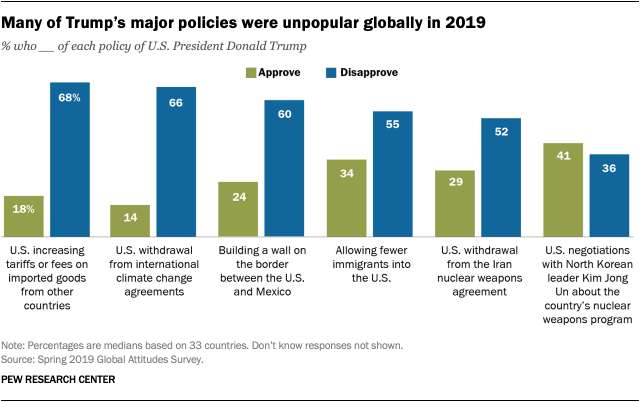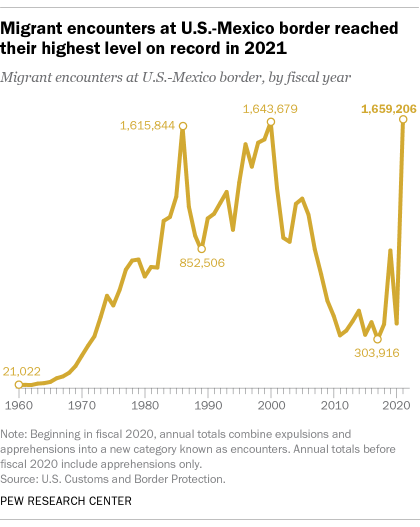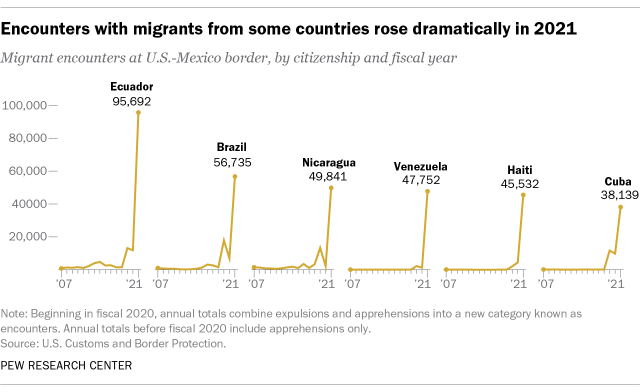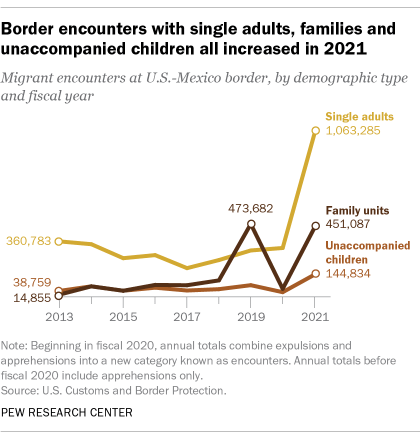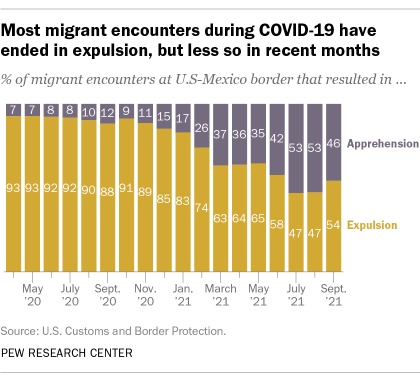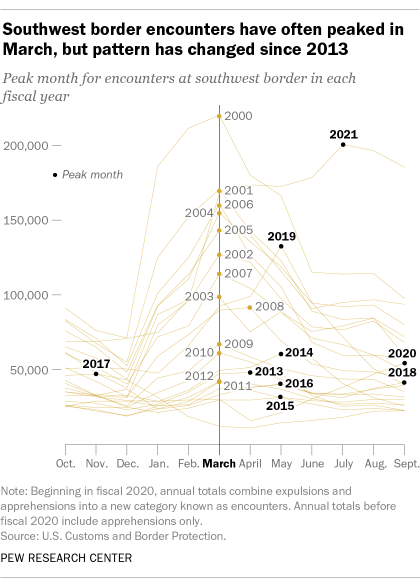|
Msg ID:
2721328 |
How many lives will be lost because +1/-0

|
Author:Old Guy
2/24/2022 8:52:28 AM
|
Basement Biden is so incompetent. He has failed on economic, border, covid policies and now his weakness on the work stage has encouraged Putin and risks drawing us into a international crises with massive implications.
Bidens strategy is one of appeasement and these foreign threats are going to snowball. Our only hope is that republicans retake the house and push Biden to pursue a strategy of peace through strength again. But currently Putin can do what ever he wants, when ever he wants. It is to late to save Ukraine.
This invasion never would have happened if the world still respected the US. I pray we can recover from basement Biden without to much loss of life.
|
 |
Return-To-Index
|
|
Msg ID:
2721333 |
Here we go with the grandstanding +1/-1

|
Author:bladeslap
2/24/2022 9:25:03 AM
Reply to: 2721328
|
Old guy,
If it were up to you, you'd blame the holocaust on Biden too.
But, given your state of mind with "stop the steal", you take your marching orders from Trump. Nothing you say is based in reality or facts. Carry on with your fairytales. You're incapable of logical reasoning and thinking; it's all based on emotions. |
 |
Return-To-Index
|
|
Msg ID:
2721334 |
Do Tell us ... +1/-1

|
Author:bladeslap
2/24/2022 9:27:31 AM
Reply to: 2721328
|
You think Trump would have gone to war or threated his idol, Putin? Nope ...
We are putting the harshest sanctions since WW2 on Russia now. That includes freezing assets of even people related to Putin ... stopping them from accessing monetary systems..Cutting off the pipeline...
You think Trump would have gone to war?
Do tell us how a Trump Stragegy would had been different...
And tell us what Biden could had done differently since you are drinking the koolaid |
 |
Return-To-Index
|
|
Msg ID:
2721343 |
With Trump there would be no need for war +1/-1

|
Author:Old Guy
2/24/2022 9:54:47 AM
Reply to: 2721334
|
Trump would have had continued the policy of strength. None of this would have happened.
Biden has been the worlds joke and sending the hoe over for meetings in Europe was like telling Putin that we don't take this serious, go ahead. |
 |
Return-To-Index
|
|
Msg ID:
2721345 |
Policy Strength? +1/-1

|
Author:bladeslap
2/24/2022 9:56:57 AM
Reply to: 2721343
|
Ya, constantly praising Putin ... He defended Putin and contradicted our own intel. Trump was Putin's puppet. You know it, we all know it.

|
 |
Return-To-Index
|
|
Msg ID:
2721346 |
Trump was an embarrasment and disgrace to our country (NT) +1/-0

|
Author:bladeslap
2/24/2022 9:57:31 AM
Reply to: 2721343
|
|
 |
Return-To-Index
|
|
Msg ID:
2721347 |
You believe the shat you're peddling? (NT) +0/-1

|
Author:Ted Walker Jr.
2/24/2022 10:07:58 AM
Reply to: 2721343
|
|
 |
Return-To-Index
|
|
Msg ID:
2721349 |
Donald Trump had no principles and no "policies" to guide him, except "What +1/-0

|
Author:TheCrow
2/24/2022 10:25:14 AM
Reply to: 2721343
|
Donald Trump had no principles and no "policies" to guide him, except "What can I do for myself right now?"
Many world leaders were quick to offer congratulatory messages to President-elect Joe Biden after his victory in this month’s U.S. presidential election. They included Germany’s Angela Merkel, Canada’s Justin Trudeau and others who have had tense relations with President Donald Trump. Citing Biden’s commitment to rejoining the Paris climate accord, France’s Emmanuel Macron suggested it is now possible to “make our planet great again.”
The French leader’s sentiments are probably shared by many ordinary citizens around the world. In international surveys conducted by Pew Research Center over the past few years, Trump has generally received lower ratings than either of his two predecessors – Barack Obama and George W. Bush – with relatively few people approving of his handling of international affairs.
Indeed, no more than a quarter of adults expressed confidence in Trump in any of the 13 countries surveyed by the Center this year. And in many nations where we have survey data for the past three administrations, the lowest ratings we’ve seen for any president have come during Trump’s time in office. For instance, just 5% of Mexicans voiced confidence in Trump’s leadership in 2017, the smallest share who expressed that view in surveys that date back to 2007.
Trump’s unpopularity has had a significant negative effect on America’s overall image. Ratings for the United States plummeted after he took office in 2017, and they have declined further over the past year, at least in part due to the widespread perception that the U.S. has handled the coronavirus pandemic poorly. In fact, in several nations that are key U.S. allies and partners, the share of the public with a favorable view of the U.S. is at its lowest point in nearly two decades of polling.
For example, just 41% of adults in the United Kingdom expressed a favorable opinion of the U.S. this year, the lowest percentage registered in any Center survey there. In France and Germany, ratings for the U.S. are essentially as low as they were in March 2003, at the height of U.S.-European tensions over the Iraq War. U.S. favorability also reached all-time lows this year in Japan, Canada, Australia, the Netherlands and Sweden.
What have people around the world not liked about Trump? Our 37-nation survey in 2017 found that many did not like his personal characteristics or leadership style. Majorities said he was arrogant, intolerant and dangerous. Few considered him well-qualified or believed that he cares about ordinary people.
There has also been considerable opposition to many of Trump’s policies, including his administration’s withdrawal from climate change agreements and the Iran nuclear deal. Trump’s efforts to make it more difficult to enter the U.S. have also been widely unpopular.
Across 33 nations surveyed in 2019, a median of 55% disapproved of the U.S. allowing fewer immigrants into the country; just 34% approved. A median of six-in-ten opposed building a wall on the U.S.-Mexico border. And majorities opposed Trump’s efforts to erect trade barriers in addition to physical barriers, with a median of nearly seven-in-ten (68%) disapproving of increased U.S. tariffs or fees on imported goods.
While America’s image has suffered during Trump’s presidency, the U.S. still has many “soft power” assets. For example, people around the world generally still embrace U.S. popular culture: A median of 65% of adults across 37 countries polled in 2017 said they like American music, movies and television.
And people still mostly associate the U.S. with the idea of individual liberty, although there has been a decline on this front in recent years. The share of adults who believe the U.S. government respects the personal freedoms of its people has dropped in many nations recently, including Germany, Canada and Australia. While this decline has continued during Trump’s presidency, it began during the Obama era. (The first decrease on this measure occurred between 2013 and 2014, as news broke about the U.S. National Security Agency’s surveillance around the world. We saw further declines in 2015 following protests in Ferguson, Missouri, in response to the police killing of Michael Brown in August 2014.)
It’s too soon to know the extent to which a new president and new policies can turn around America’s battered image, but a change like this has happened before. After years of relatively poor ratings during the Bush administration, views of the U.S. improved significantly in many regions after Obama took office in 2009. Obama’s policies weren’t uniformly popular over the course of his presidency, but people generally saw his approach to world affairs as more multilateralist than Bush’s, and ratings for the U.S. remained relatively high in most nations throughout his tenure.
Richard Wike is director of global attitudes research at Pew Research Center.
v>
|
 |
Return-To-Index
|
|
Msg ID:
2721353 |
Biden has been the worlds joke and sending the hoe over for meetings in Eu +1/-0

|
Author:TheCrow
2/24/2022 10:42:11 AM
Reply to: 2721343
|
"Biden has been the worlds joke and sending the hoe over for meetings in Europe was like telling Putin that we don't take this serious, go ahead."
Trump and Putin sitting in the tree
K-i-s-s-i-n-g! (spell it out)
First comes love.
Then comes marriage.
Then comes baby Vlad in the baby carriage,
Sucking his thumb,
Wetting his pants,
Doing the hula, hula dance!
Trumpists are simple, bellicose jingoes, with the exception that they're not and have not been flocking down to enlist. Somebody else of their kids should fight for their independence, international interests. That's TRUMP ALL THE WAY! Example, his crippling heelspurs that didn't interfere with his basketball or golf. Golf is a sport, athletic? It's an excuse to dring beer....
But, as to internatioonal views of Biden's presidency? After the ineffective, ignorant, arrogant Trump presidency, even Biden looks good to the world.
Donald Trump was the only candidate that could get Biden elected after 30+ years of campaigning for the office.
June 10, 2021 at 9:01 a.m. EDT
President Biden has promised the world that “America is back.”
As he takes his first trip abroad as president, a Pew Research Center global survey released Thursday shows that many in advanced economies believe it.
Trust in the U.S. president fell to historic lows in most countries surveyed during Donald Trump’s presidency, according to Pew.
Under Biden, it has soared. In the 12 countries surveyed both this year and last, a median of 75 percent of respondents expressed confidence in Biden to “do the right thing regarding world affairs,” Pew found, compared with 17 percent for Trump last year. Sixty-two percent of respondents now have a favorable view of the United States vs. 34 percent at the end of Trump’s presidency.
“The election of Joe Biden as president has led to a dramatic shift in America’s international image,” the Pew report reads.
The findings come a day after Biden touched down in England on the first leg of a whirlwind trip through Europe. On his agenda: a meeting of the Group of Seven nations in Cornwall, a NATO summit in Brussels, and tête-à-têtes with British Prime Minister Boris Johnson, Turkish President Recep Tayyip Erdogan and Russian President Vladimir Putin.
In an op-ed in The Washington Post, Biden cast his voyage as a sort of redemption tour — a chance to revitalize the nation’s strained alliances and rally like-minded democracies to “meet the challenges and deter the threats of this new age.”
The Pew findings suggest that he will encounter leaders whose publics are confident in his leadership and supportive of key foreign policy priorities.
The United States’ favorability rating grew at least 23 percentage points from last year in France, Germany, Italy and the United Kingdom, and a majority of respondents in all four view the country positively.
Among all 16 publics surveyed this spring, German Chancellor Angela Merkel ranks just ahead of Biden in the percentage of respondents who said they trust the leader’s decision-making on world affairs, with a median score of 77 percent. But Biden, with 74 percent, garnered higher rates of confidence than French President Emmanuel Macron, Putin and Chinese President Xi Jinping.
“In many cases, however, the share who have confidence in Biden is not as high as the share who had confidence in [President Barack] Obama at the start or end of his presidency,” the Pew report notes.
Alexandra de Hoop Scheffer, director of the German Marshall Fund’s Paris office, said the lack of a “Biden effect” compared with the “Obama effect” on public opinion in Europe was likely in part due to the lasting effects of Trump’s tenure.
“I think this has left a certain level of legacy across Europe, the sort of distrust this has created between Europeans and Americans,” she said.
Trump’s withdrawal from the Paris agreement was widely criticized among advanced economies. Since taking office, Biden has sought to position the United States as a global leader in fighting climate change; a median of 85 percent supported the United States rejoining the Paris climate agreement.
Perceptions of the United States’ handling of the coronavirus pandemic have also improved. Still, among all the publics surveyed, a median of 37 percent think the United States has done a good job. Many rate the United States below Germany, the WHO, China and the European Union in terms of pandemic response.
And signs of skepticism about the United States’ dependability remain.
Among the 16 publics Pew surveyed in 2021, majorities or pluralities described the United States as a “somewhat reliable” partner. The proportion of respondents who said the United States is “very reliable” was below 20 percent in every place.
De Hoop Scheffer said that while Europeans have been very receptive to Biden’s “America is back” message and his championing of democracy, concerns about America’s approach to global decision-making have lingered.
“We don’t want to go back to the sort of old patterns of transatlantic cooperation where the U.S. leads and Europe follows,” she said. “This is the legacy of the Trump era that we should not underestimate.”
The Biden administration’s decision to withdraw U.S. forces from Afghanistan, for example, left NATO partners feeling blindsided.
The survey shows attitudes are mixed about how well the U.S. political system functions, and in most surveyed publics, less than 10 percent of respondents said it works very well.
“Publics in the advanced economies surveyed are largely skeptical that democracy in the U.S. is a good example for other countries to follow,” the report reads.
Majorities in most places think the United States “used to be a good example, but has not been in recent years,” while up to about a quarter reject the notion that it has ever been a model democracy. Young people were particularly skeptical in about half of places surveyed.
Political polarization in the United States is a major factor, de Hoop Scheffer said.
“If you have a divided political scene and polarization as you have today in the U.S. Congress, then the American president will not be able to have a long-term commitment on the international scene,” she said, pointing to Republican opposition to a Biden administration-propelled G-7 proposal for a 15 percent global minimum tax.
Most people surveyed continued to say the United States doesn’t factor the interests of countries like theirs into foreign policy decisions, although attitudes across Europe vary.
A majority of respondents in Asian-Pacific regions also said the United States discounts their interests, with the exception of Japan. Japanese Prime Minister Yoshihide Suga was the first foreign leader Biden hosted at the White House.
NATO, meanwhile, has a median favorability rating of 61 percent, and positive views of the alliance are “at or near all-time highs across several member states,” the Pew report reads.
It’s a finding that will hearten leaders, including Biden, who seek to breathe fresh life into NATO next week. The alliance took a beating in recent years when Trump threatened to pull out of it and Macron declared that it was experiencing “brain death.”
Pew said its 2021 findings on the United States’ international image were based on data from nationally representative surveys of more than 16,000 adults in 16 advanced economies conducted over the phone from March to May. Findings related to the coronavirus pandemic also incorporated a survey of about 2,600 U.S. adults conducted in February 2021 using Pew’s American Trends Panel.
By Claire Parker
Claire Parker writes about foreign affairs for The Washington Post.
|
 |
Return-To-Index
|
|
Msg ID:
2721348 |
How many lives will be lost because +0/-0

|
Author:TheCrow
2/24/2022 10:10:28 AM
Reply to: 2721328
|
"Basement Biden is so incompetent. He has failed on economic..."
Trump's administration featured the most severe economic contraction and highest unemployment rate since the Great Depression.
"border"
Notice in the article and charts below that the 'encounters' reached their lowest points during or immediately after Obama's administration.
Immigrants walk toward the Rio Grande to cross into Del Rio, Texas, on Sept. 23, 2021, from Ciudad Acuna, Mexico. (John Moore/Getty Images)
The U.S. Border Patrol reported more than 1.6 million encounters with migrants along the U.S.-Mexico border in the 2021 fiscal year, more than quadruple the number of the prior fiscal year and the highest annual total on record.
The number of encounters had fallen to just over 400,000 in fiscal 2020 as the coronavirus outbreak slowed migration across much of the world. But encounters at the southwest border rebounded sharply in fiscal 2021 and ultimately eclipsed the previous annual high recorded in fiscal 2000, according to recently published data from U.S. Customs and Border Protection (CBP), the federal agency that encompasses the Border Patrol.
Migrant encounters refer to two distinct kinds of events: expulsions, in which migrants are immediately expelled to their home country or last country of transit, and apprehensions, in which migrants are detained in the United States, at least temporarily.
Since the onset of the coronavirus pandemic, most encounters have resulted in expulsion from the U.S., unlike before the pandemic, when the vast majority ended in apprehension instead. The Trump administration began expelling migrants in March 2020 under a public health order aimed at limiting the spread of COVID-19. The Biden administration has continued to expel migrants under the same order.
Below is a closer look at the shifting dynamics at the southwest border, based on the recent CBP statistics. Most of these statistics refer to federal fiscal years, which run from Oct. 1 to Sept. 30, as opposed to calendar years. It’s also important to note that encounters refer to events, not people, and that some migrants are encountered more than once.
Southwest border encounters increased to their highest recorded level in fiscal 2021. The Border Patrol reported 1,659,206 encounters with migrants at the U.S.-Mexico border last fiscal year, narrowly exceeding the prior highs of 1,643,679 in 2000 and 1,615,844 in 1986.
The large number of encounters in fiscal 2021 dwarfed the total during the last major wave of migration at the southwest border, which occurred in fiscal 2019. The Border Patrol recorded 851,508 encounters that year.
While the number of encounters was the highest on record last fiscal year, the number of individuals encountered was considerably lower. That’s because more than a quarter of all migrant encounters at U.S. borders in both fiscal 2021 and fiscal 2020 (27% and 26%, respectively) involved repeat crossers, according to CBP statistics. By comparison, the proportion of repeat border crossers was much lower in the 2019 fiscal year (7%), before the Border Patrol began regularly expelling migrants during the coronavirus outbreak. (These recidivism statistics include encounters at all U.S. borders. While separate statistics for only the U.S.-Mexico border are not available, encounters at the southwest border have accounted for more than 97% of total encounters in recent years.)
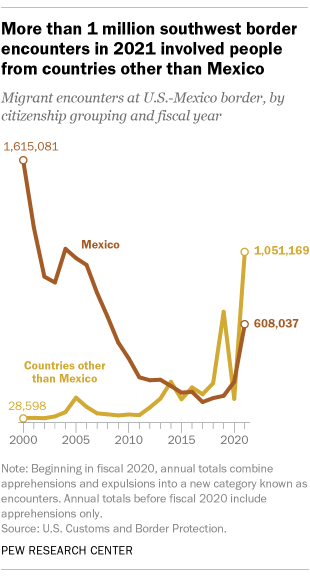 A record number of encounters in fiscal 2021 involved people from countries other than Mexico. Mexico was the single most common origin country for migrants encountered at the border in fiscal 2021. The Border Patrol reported 608,037 encounters with Mexican nationals last year, accounting for 37% of the total. The remaining 1,051,169 encounters, or 63%, involved people from countries other than Mexico – by far the highest total for non-Mexican nationals in CBP records dating back to 2000.
Most of the encounters with non-Mexicans in fiscal 2021 involved people from the Northern Triangle countries of Honduras, Guatemala and El Salvador. There were 308,931 encounters with people from Honduras last fiscal year (representing 19% of all encounters), 279,033 with people from Guatemala (17%) and 95,930 with people from El Salvador (6%). The Northern Triangle region has been a major source of migration at the U.S-Mexico border in recent years.
Encounters soared in fiscal 2021 for some countries that have not historically been common sources of migration at the U.S.-Mexico border. The number of encounters involving people from Ecuador, for example, increased more than eightfold, from 11,861 in fiscal 2020 to 95,692 in fiscal 2021. There were also stark increases in encounters involving people from Brazil (from 6,946 to 56,735), Nicaragua (from 2,123 to 49,841), Venezuela (from 1,227 to 47,752), Haiti (from 4,395 to 45,532) and Cuba (from 9,822 to 38,139).
Economic, social and political instability in some of these countries likely played a role in the spike in encounters at the U.S.-Mexico border last fiscal year. In Ecuador, widespread economic problems and the COVID-19 pandemic have led many migrants to make the journey north. Haiti, meanwhile, has faced a number of challenges in recent years, ranging from natural disasters to the assassination of its president in July.
Related: Biden administration widens scope of Temporary Protected Status for immigrants
The increase in encounters at the U.S.-Mexico border didn’t just involve people from Latin America or the Caribbean region. The number of encounters involving people from Romania rose from 266 in fiscal 2020 to 4,029 in fiscal 2021, while the number involving people from Turkey increased from 67 to 1,366.
Migrant encounters increased across demographic groups in fiscal 2021, but single adults continued to account for the large majority. Encounters with unaccompanied children rose from 30,557 in fiscal 2020 to 144,834 in fiscal 2021, while encounters with people traveling in families increased from 52,230 to 451,087.
By far the largest number and share of encounters involved single adults. There were 1,063,285 encounters with single adults in fiscal 2021, up from 317,864 the year before. More than six-in-ten encounters (64%) involved single adults, though that was down from 79% in fiscal 2020.
Migrant encounters more than doubled in every sector along the U.S.-Mexico border in fiscal 2021. The largest numerical increase occurred in the Rio Grande Valley sector, where there were 549,077 encounters last fiscal year, up from 90,206 the year before. But the largest proportional increase occurred in the Yuma sector, where encounters increased thirteenfold, from 8,804 in fiscal 2020 to 114,488 in fiscal 2021.
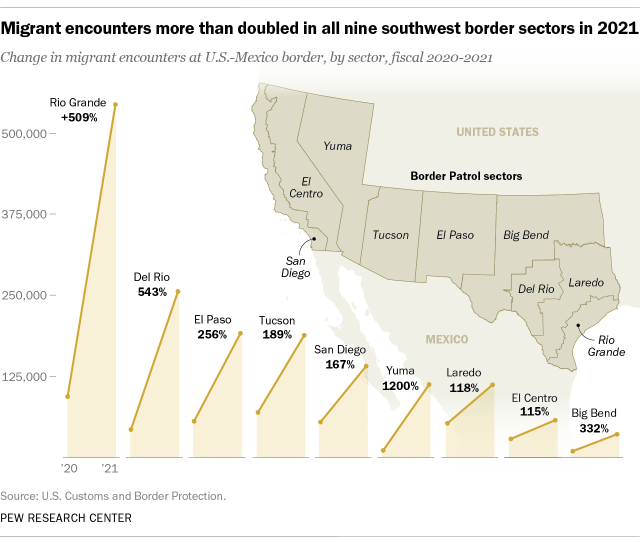
Since the coronavirus outbreak began, most migrant encounters have resulted in expulsion from the U.S., rather than apprehension within the country. In March 2020, the administration of former President Donald Trump invoked Title 42, a public health order allowing the Border Patrol to expel migrants immediately in an effort to control the domestic spread of the coronavirus. President Joe Biden’s administration has continued to expel migrants under Title 42, though to a lesser extent than the Trump administration.
About two-thirds (66%) of all migrant encounters ended in expulsion between April 2020, the first full month after Title 42 was invoked, and September 2021, the end of the 2021 fiscal year. The remaining 34% resulted in apprehension. But the share of encounters resulting in expulsion has decreased under the Biden administration. In September 2021, 54% of encounters ended in expulsion, down from 74% in February 2021, the first full month after Biden took office.
Seasonal migration patterns have changed in recent years. Since 2000, border encounters have typically peaked in the spring – most often in March – before declining during the hot summer months, when migration journeys become more perilous. But the pattern has changed since 2013, with the annual peak occurring in months other than March. July was the peak month in fiscal 2021, with the number of encounters (200,658) far exceeding the total recorded in March (169,216), even though temperatures in July are typically much higher.
Note: This is an update of a post originally published on April 10, 2019.
"covid policies"
Trump's "covid policies" initiated the Covid Epidemic? Pandemic? whatever. He announced it to be totally under control when there were 1? 15? cases in America. When the Secretary of Health and Human Services declared a National Emergency on March 13, 2020 there were 3989 cases, an increase of 26,593% over Trump's "totally under control". Was he stupid, ignorant or lying to the American public?
"and now his weakness on the work stage has encouraged Putin and risks drawing us into a international crises with massive implications."
"Bidens strategy is one of appeasement and these foreign threats are going to snowball. Our only hope is that republicans retake the house and push Biden to pursue a strategy of peace through strength again. But currently Putin can do what ever he wants, when ever he wants. It is to late to save Ukraine."
"This invasion never would have happened if the world still respected the US. I pray we can recover from basement Biden without to much loss of life."
What is our primary military agency in Western Europe, organized specifically to respond to Soviet/Russian aggression? NATO. Trump and Trumpists wanted America to minimize if not eliminate our support for NATO:
From disparaging NATO member states to calling it "obsolete," US President Donald Trump has rarely said something positive about the decades-old military alliance. DW looks at the US president's most memorable quotes.
Trump on NATO: A war of words
Even before taking office, US President Donald Trump's relationship with NATO has been a tumultuous one, to say the least. He has disparaged the trans-Atlantic alliance, once describing it as "obsolete" and a relic of the Cold War. Here are Trump's most memorable quotes about the military alliance, even if they are at times false.
'Days of the Soviet Union'
While on the campaign trail in 2016, Trump made clear that he saw NATO as a relic of the Cold War. "You know, we're dealing with NATO from the days of the Soviet Union, which no longer exists. We need to either transition into terror or we need something else." But his remarks didn't account for how the alliance backed the US well after the collapse of the Soviet Union, especially in Afghanistan.
'Germany owes vast sums'
Trump has made defense spending his main talking point on NATO. But he has falsely accused member states of owing money to Washington, saying: "Germany owes vast sums of money to NATO, and the United States must be paid more for the powerful, and very expensive, defense it provides to Germany." The problem is NATO doesn't work like that. No money is owed to the alliance for defense or otherwise.
'Obsolete'
Days before his inauguration, Trump caught NATO members off guard when he claimed the alliance was "obsolete" and threatened to withdraw support. "I said a long time ago that NATO had problems: Number one, it was obsolete, because it was designed many, many years ago." Months later, he retracted his statement, citing changes within the alliance. "Now they fight terrorism," he said.
'Doesn't sound very smart'
Trump had tended to lump trade between US allies with how much Washington spends on defense. "We are spending a fortune on military in order to lose $800 billion (in trade losses). That doesn't sound very smart to me," Trump said. The problem is that while NATO members have agreed to spend 2 percent of their GDP on defense, the alliance has nothing to do with international trade.
'We are the schmucks'
During a 2018 rally in Montana, Trump hit out at European allies, saying: "They want (us) to protect against Russia, and yet they pay billions of dollars to Russia, and we're the schmucks paying for the whole thing." Trump was referring to Russia as Europe's primary source for oil and natural gas, but he created a false dichotomy between energy reliance and NATO's defense spending goal.
'Congratulations, you're in World War III'
In an interview with Fox News, Trump was asked why the US should jump to the defense of NATO ally Montenegro if it was attacked. The president said he asked himself the same question, a remark that appeared to undermine the alliance's collective defense clause. Trump went on to describe Montenegrins as "very strong" and "very aggressive," and that that aggression risked starting World War III. |
 |
Return-To-Index
|
|

